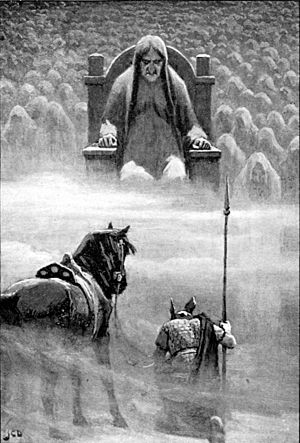Hel (goddess) facts for kids

Hel is a powerful goddess in Norse mythology. She is the daughter of Loki, the famous trickster god, and the giantess Angrboða. Her siblings are the giant serpent Jörmungandr and the mighty wolf Fenrir. Hel's main job is to rule over the realm of the dead, which is also called Hel or Niflheim. This is where people go peacefully in the afterlife if they die from sickness or old age.
Contents
Hel's Family and Where She Came From
Hel's family is quite unusual! Her father is Loki, who is known for being clever and sometimes causing trouble among the gods. Her mother is Angrboða, a giantess.
Loki and Angrboða had two other very famous children. One was Jörmungandr, a huge serpent so big it wraps around the entire world! The other was Fenrir, a giant wolf. Fenrir is destined to play a big part in Ragnarök, which is the final battle that ends the Norse world.
Hel wasn't born in a fancy palace. Instead, she came from a dark and mysterious place. This shows her strong connection to the underworld. The old Norse stories don't give an exact date for her birth. These tales were told by people for many years before they were written down. So, the exact time she was born is a mystery, but she is a very important part of the Norse creation stories.
Hel's Realm: The Underworld
Hel's most important role is ruling Helheim, the underworld in Norse mythology. Helheim is not a fiery, scary place like "hell" in some other stories. It's more of a shadowy, quiet realm. It's where people who die from illness or old age go. It's not a place of endless pain, but rather a calm, peaceful existence. You can think of it as a place of soft light and quiet stillness.
Helheim is described in various old poems and sagas. These descriptions often use metaphors and symbols. It's a land of mist and shadows, where the sun never shines. The images suggest a cold, empty landscape. This reflects the nature of death and how time passes. There are no exact maps or geographical details given. This is because Helheim is a spiritual place, not a physical one you can find on a map.
Hel's Appearance and What She's Like
Hel's appearance is often described as being half-beautiful and half-decayed. This unique look shows her role as the ruler of a place that is part of life and part of death. One side of her body is bright and lovely, while the other side looks like it's decaying and ghostly.
She is often shown with a serious expression. This reflects the quiet nature of her realm. She isn't mean or evil, but she's certainly not very welcoming. Her job is to welcome those who die and guide them to their final resting place in Helheim. She doesn't judge people's souls. Instead, she is like a caretaker for the dead.
Hel's Role in Norse Stories
Hel's main role is that of a ruler and caretaker. She doesn't usually get involved in what happens in the living world. She only steps in if a specific myth or prophecy directly involves her. Her power is mostly limited to her own realm, Helheim. She doesn't try to hurt or punish living people. However, her very existence reminds everyone that death is something that will happen to all of us.
Her presence in Norse mythology helps us remember that everyone will die. The Norse people were not afraid of death. They accepted it as a normal part of life's journey. Hel's realm was not a place of endless punishment. It was simply a destination for those who passed away. This idea is different from many other mythologies. Those often focus on judging souls and giving out eternal rewards or punishments.
What Hel Represents
Hel represents the natural cycle of life and death. She shows the unavoidable change from being alive to no longer existing. Her realm, Helheim, is a part of the bigger universe. It is a necessary part of keeping the universe balanced.
Images for kids
-
"Loki's Brood" (1905) by Emil Doepler.
See also
 In Spanish: Hela para niños
In Spanish: Hela para niños



